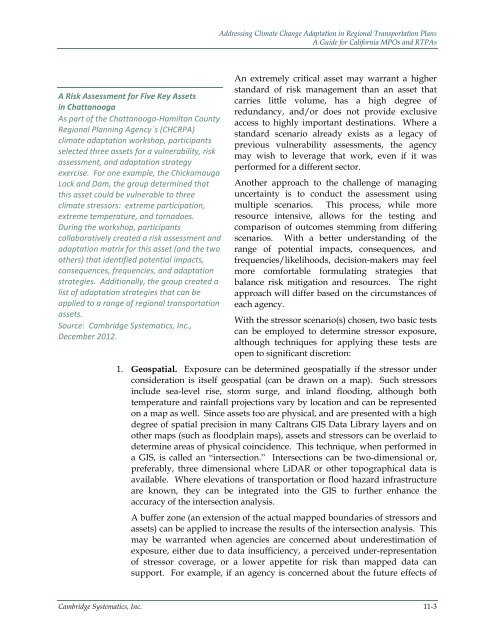addressing climate change adaptation in regional transportation plans
addressing climate change adaptation in regional transportation plans
addressing climate change adaptation in regional transportation plans
Create successful ePaper yourself
Turn your PDF publications into a flip-book with our unique Google optimized e-Paper software.
Address<strong>in</strong>g Climate Change Adaptation <strong>in</strong> Regional Transportation PlansA Guide for California MPOs and RTPAsA Risk Assessment for Five Key Assets<strong>in</strong> ChattanoogaAs part of the Chattanooga‐Hamilton CountyRegional Plann<strong>in</strong>g Agency’s (CHCRPA)<strong>climate</strong> <strong>adaptation</strong> workshop, participantsselected three assets for a vulnerability, riskassessment, and <strong>adaptation</strong> strategyexercise. For one example, the ChickamaugaLock and Dam, the group determ<strong>in</strong>ed thatthis asset could be vulnerable to three<strong>climate</strong> stressors: extreme participation,extreme temperature, and tornadoes.Dur<strong>in</strong>g the workshop, participantscollaboratively created a risk assessment and<strong>adaptation</strong> matrix for this asset (and the twoothers) that identified potential impacts,consequences, frequencies, and <strong>adaptation</strong>strategies. Additionally, the group created alist of <strong>adaptation</strong> strategies that can beapplied to a range of <strong>regional</strong> <strong>transportation</strong>assets.Source: Cambridge Systematics, Inc.,December 2012.An extremely critical asset may warrant a higherstandard of risk management than an asset thatcarries little volume, has a high degree ofredundancy, and/or does not provide exclusiveaccess to highly important dest<strong>in</strong>ations. Where astandard scenario already exists as a legacy ofprevious vulnerability assessments, the agencymay wish to leverage that work, even if it wasperformed for a different sector.Another approach to the challenge of manag<strong>in</strong>guncerta<strong>in</strong>ty is to conduct the assessment us<strong>in</strong>gmultiple scenarios. This process, while moreresource <strong>in</strong>tensive, allows for the test<strong>in</strong>g andcomparison of outcomes stemm<strong>in</strong>g from differ<strong>in</strong>gscenarios. With a better understand<strong>in</strong>g of therange of potential impacts, consequences, andfrequencies/likelihoods, decision-makers may feelmore comfortable formulat<strong>in</strong>g strategies thatbalance risk mitigation and resources. The rightapproach will differ based on the circumstances ofeach agency.With the stressor scenario(s) chosen, two basic testscan be employed to determ<strong>in</strong>e stressor exposure,although techniques for apply<strong>in</strong>g these tests areopen to significant discretion:1. Geospatial. Exposure can be determ<strong>in</strong>ed geospatially if the stressor underconsideration is itself geospatial (can be drawn on a map). Such stressors<strong>in</strong>clude sea-level rise, storm surge, and <strong>in</strong>land flood<strong>in</strong>g, although bothtemperature and ra<strong>in</strong>fall projections vary by location and can be representedon a map as well. S<strong>in</strong>ce assets too are physical, and are presented with a highdegree of spatial precision <strong>in</strong> many Caltrans GIS Data Library layers and onother maps (such as floodpla<strong>in</strong> maps), assets and stressors can be overlaid todeterm<strong>in</strong>e areas of physical co<strong>in</strong>cidence. This technique, when performed <strong>in</strong>a GIS, is called an “<strong>in</strong>tersection.” Intersections can be two-dimensional or,preferably, three dimensional where LiDAR or other topographical data isavailable. Where elevations of <strong>transportation</strong> or flood hazard <strong>in</strong>frastructureare known, they can be <strong>in</strong>tegrated <strong>in</strong>to the GIS to further enhance theaccuracy of the <strong>in</strong>tersection analysis.A buffer zone (an extension of the actual mapped boundaries of stressors andassets) can be applied to <strong>in</strong>crease the results of the <strong>in</strong>tersection analysis. Thismay be warranted when agencies are concerned about underestimation ofexposure, either due to data <strong>in</strong>sufficiency, a perceived under-representationof stressor coverage, or a lower appetite for risk than mapped data cansupport. For example, if an agency is concerned about the future effects ofCambridge Systematics, Inc. 11-3
















